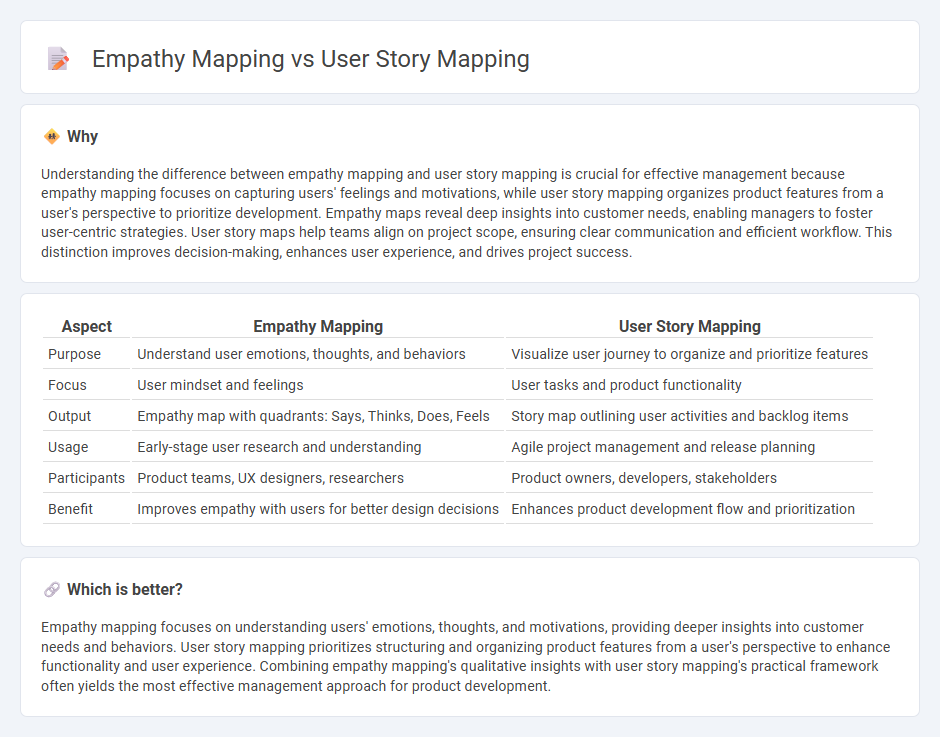
Empathy mapping focuses on understanding users' feelings, thoughts, and pain points to create user-centered solutions. User story mapping organizes user stories to visualize the product backlog and prioritize development tasks effectively. Explore more to discover how these tools enhance product management and user experience.
Why it is important
Understanding the difference between empathy mapping and user story mapping is crucial for effective management because empathy mapping focuses on capturing users' feelings and motivations, while user story mapping organizes product features from a user's perspective to prioritize development. Empathy maps reveal deep insights into customer needs, enabling managers to foster user-centric strategies. User story maps help teams align on project scope, ensuring clear communication and efficient workflow. This distinction improves decision-making, enhances user experience, and drives project success.
Comparison Table
| Aspect | Empathy Mapping | User Story Mapping |
|---|---|---|
| Purpose | Understand user emotions, thoughts, and behaviors | Visualize user journey to organize and prioritize features |
| Focus | User mindset and feelings | User tasks and product functionality |
| Output | Empathy map with quadrants: Says, Thinks, Does, Feels | Story map outlining user activities and backlog items |
| Usage | Early-stage user research and understanding | Agile project management and release planning |
| Participants | Product teams, UX designers, researchers | Product owners, developers, stakeholders |
| Benefit | Improves empathy with users for better design decisions | Enhances product development flow and prioritization |
Which is better?
Empathy mapping focuses on understanding users' emotions, thoughts, and motivations, providing deeper insights into customer needs and behaviors. User story mapping prioritizes structuring and organizing product features from a user's perspective to enhance functionality and user experience. Combining empathy mapping's qualitative insights with user story mapping's practical framework often yields the most effective management approach for product development.
Connection
Empathy mapping and user story mapping are connected through their focus on understanding user needs and behaviors to enhance product development. Empathy mapping captures detailed insights about users' emotions, thoughts, and pain points, which inform the creation of user stories that reflect real experiences and priorities. This connection ensures that management teams develop more user-centered solutions by aligning user insights with actionable development tasks.
Key Terms
User Activities (User Story Mapping)
User story mapping centers on organizing user activities into a structured workflow to visualize the sequence and priority of tasks, enhancing product development alignment. It breaks down complex processes into manageable user stories, facilitating better team collaboration and sprint planning. Explore how user story mapping drives efficient project management and product delivery.
User Goals (Empathy Mapping)
Empathy mapping centers on understanding user goals and emotions by capturing what users say, think, feel, and do, enabling teams to gain deep insights into user motivations and pain points. User story mapping, while also user-focused, organizes functionality and tasks to prioritize product features based on user journeys rather than emotional context. Explore the differences in how these tools enhance user-centered design and product development by diving deeper into their applications.
Pain Points (Empathy Mapping)
Empathy mapping centers on uncovering users' pain points by capturing their feelings, thoughts, and frustrations to foster a deep understanding of their experiences. User story mapping, while organizing product features and user journeys, prioritizes functional requirements over emotional insights. Explore techniques to balance both methods for comprehensive product design.
Source and External Links
User Story Mapping: Create a Map in 6 Steps - Aha.io - User story mapping is a visual exercise where product teams organize and prioritize user stories into a structured map to create a more delightful user experience by focusing on customer goals and needs.
Mapping User Stories in Agile - NN/g - User-story mapping helps Agile teams collaboratively define, visualize, and prioritize product features from the user's perspective, turning broad activities into detailed, actionable stories that can guide sprint planning and backlog management.
The Ultimate Guide to User Story Mapping - Easy Agile - User story mapping begins with identifying personas and customer journey steps, then listing high-level activities in order, and finally breaking those into specific user stories under each activity to ensure the product delivers real value in a logical, user-centered sequence.
 dowidth.com
dowidth.com